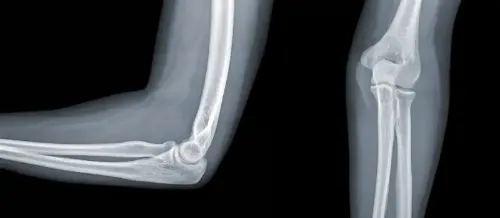Elbow osteoarthritis
"The most interesting therapeutic advances in this field are arthroscopy and arthroplasties or prostheses".
DR. ANTONIO ARENAS
SPECIALIST. ORTHOPEDIC SURGERY AND TRAUMATOLOGY DEPARTMENT

Osteoarthritis of the elbow is the degenerative disease of this joint with loss of the cartilage that covers the joint surfaces.
Loss of articular cartilage and hardening of the bone surfaces with formation of osteophytes (bone growth on the periphery of the joint) occurs.
In most cases, it is secondary to excessive exercise, previous trauma, osteochondritis dissecans lesions or synovial chondromatosis.

What are the symptoms of osteoarthritis of the elbow?
For a long time it remains asymptomatic and its clinical presentation can be variable, with a more or less painful loss of mobility.
It can, by the formation of osteophytes at the level of the epitrochleocranial channel, produce a compromise of the ulnar nerve that requires an operation.
Osteoarthritis can also affect the humeroradial joint and produce alterations at the level of the head of the radius, sometimes related to repeated traumatisms.
The most common symptoms are:
- Joint pain.
- Inflammation of the joint.
- Problems of disability at a functional level.
- Articular stiffness.
Do you have any of these symptoms?
You may have osteoarthritis in your elbow
How is elbow osteoarthritis diagnosed?

For the diagnosis of elbow osteoarthritis, the clinical examination by the specialist and the complement of imaging tests will be sufficient.
In the examination, pain, swelling, crackling or blockage can be detected. In 30-50% of the cases, paresthesia produced by compression may appear.
The image study allows to evaluate the osteocartilaginous lesions and to precise the position of the osteophytes and the foreign bodies.
AP and lateral elbow radiographs are usually sufficient in the initial evolution.
In cases of advanced osteoarthritis, where surgery can be considered, other imaging tests are useful, especially CT or MRI.
How is elbow osteoarthritis treated?
The aim of treatment is to relieve pain and maintain functional capacity
In the initial forms, the treatment is generally symptomatic, but if it fails, the treatment of choice is conservative surgery, with joint cleaning, removal of the osteophytes and release of the capsule.
In this indication, there is a growing interest in arthroscopy.
If the alteration of the joint interline is important, the choice is between arthrolysis with arthroplasty and humerocubital tissue interposition or elbow prosthesis.
- Arthrolysis: release of joint adhesions. It is necessary a collaboration on the part of the patient to initiate an active early mobilization of the elbow. It is important in the postoperative period to use devices for continuous passive mobilization.
- Arthroplasty: In elbows with serious joint deterioration, the defect can be reconstructed with prosthesis, obtaining good results in the medium term.
- Arthroscopy: For the removal of small intraarticular bodies, joint cleaning, biopsy and diagnostic evaluation.
Where do we treat it?
IN NAVARRE AND MADRID
The Department of Orthopedic Surgery and Traumatology
of the Clínica Universidad de Navarra
The Department of Orthopedic Surgery and Traumatology covers the full spectrum of congenital or acquired conditions of the musculoskeletal system including trauma and its aftermath.
Since 1986, the Clinica Universidad de Navarra has had an excellent bank of osteotendinous tissue for bone grafting and offers the best therapeutic alternatives.
Organized in care units
- Hip and knee.
- Spine.
- Upper extremity.
- Pediatric orthopedics.
- Ankle and foot.
- Musculoskeletal tumors.

Why at the Clinica?
- Experts in arthroscopic surgery.
- Highly qualified professionals who perform pioneering techniques to solve traumatological injuries.
- One of the centers with the most experience in bone tumors.




















